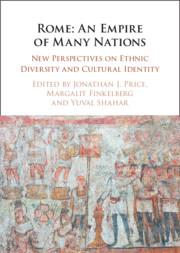Book contents
- Rome: An Empire of Many Nations
- Reviews
- Rome: An Empire of Many Nations
- Copyright page
- Contents
- Figures
- Contributors
- Acknowledgments
- Abbreviations
- Introduction
- Part I Ethnicity and Identity in the Roman Empire
- Part II Culture and Identity in the Roman Empire
- Part III Ethnicity and Identity in the Roman Empire
- 10 Religious Pluralism in the Roman Empire
- 11 Rome’s Attitude to Jews after the Great Rebellion – Beyond Raison d’état?
- 12 Between ethnos and populus
- 13 Local Identities of Synagogue Communities in the Roman Empire
- 14 The Good, the Bad and the Middling
- 15 The Severans and Rabbi Judah ha-Nasi
- Part IV Iudaea/Palaestina
- Bibliography
- General Index
- Index Locorum
14 - The Good, the Bad and the Middling
Roman Emperors in Talmudic Literature*
from Part III - Ethnicity and Identity in the Roman Empire
- Rome: An Empire of Many Nations
- Reviews
- Rome: An Empire of Many Nations
- Copyright page
- Contents
- Figures
- Contributors
- Acknowledgments
- Abbreviations
- Introduction
- Part I Ethnicity and Identity in the Roman Empire
- Part II Culture and Identity in the Roman Empire
- Part III Ethnicity and Identity in the Roman Empire
- 10 Religious Pluralism in the Roman Empire
- 11 Rome’s Attitude to Jews after the Great Rebellion – Beyond Raison d’état?
- 12 Between ethnos and populus
- 13 Local Identities of Synagogue Communities in the Roman Empire
- 14 The Good, the Bad and the Middling
- 15 The Severans and Rabbi Judah ha-Nasi
- Part IV Iudaea/Palaestina
- Bibliography
- General Index
- Index Locorum
Summary
Talmudic literature, throughout all its chronological phases, relates to various Roman emperors. Nine emperors are mentioned explicitly by name, and among these are six who are especially notable, from three different periods. First, the period of the major Jewish revolts: Vespasian and Titus are mentioned for the War of the Destruction of the Temple, Trajan for the Diaspora revolts and Hadrian for the Bar Kochba Revolt. These are the “wicked” emperors of Talmudic literature, with Hadrian presented as the worst of all. Second, the golden age of relations between Judaea and Rome in the Severan period: “Antoninus,” usually identified with Caracalla, is presented as the “good” emperor par excellence. Finally, in the middle of the scale between the “wicked” and the “good” emperors we find Diocletian, the interesting emperor whose presence is strongly felt, as he was responsible for the development of the whole region.
Keywords
- Type
- Chapter
- Information
- Rome: An Empire of Many NationsNew Perspectives on Ethnic Diversity and Cultural Identity, pp. 239 - 259Publisher: Cambridge University PressPrint publication year: 2021
- 2
- Cited by

